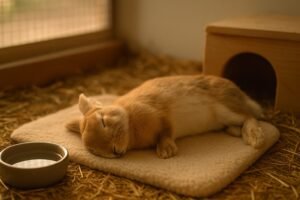How cold is too cold for a pet rabbit? Generally, when temperatures drop below 32°F (0°C), your pet rabbit can be at risk of cold stress and other health issues. This guide will provide you with detailed information on rabbits’ cold tolerance, signs of cold stress, and essential tips for keeping your rabbit warm and comfortable through winter.
Key Takeaways
-
Rabbits can handle cold temperatures above 32°F, but prolonged exposure to lower temperatures can be harmful. Their ideal comfort range is between 60-70°F.
-
Watch for signs of cold stress in rabbits, such as shivering or lethargy. Immediate action is needed if they show severe symptoms like weak pulses or shallow breathing.
-
To keep rabbits warm in winter, insulate their hutch, provide extra bedding, and consider moving them indoors during extreme weather.
Understanding a Rabbit’s Cold Tolerance
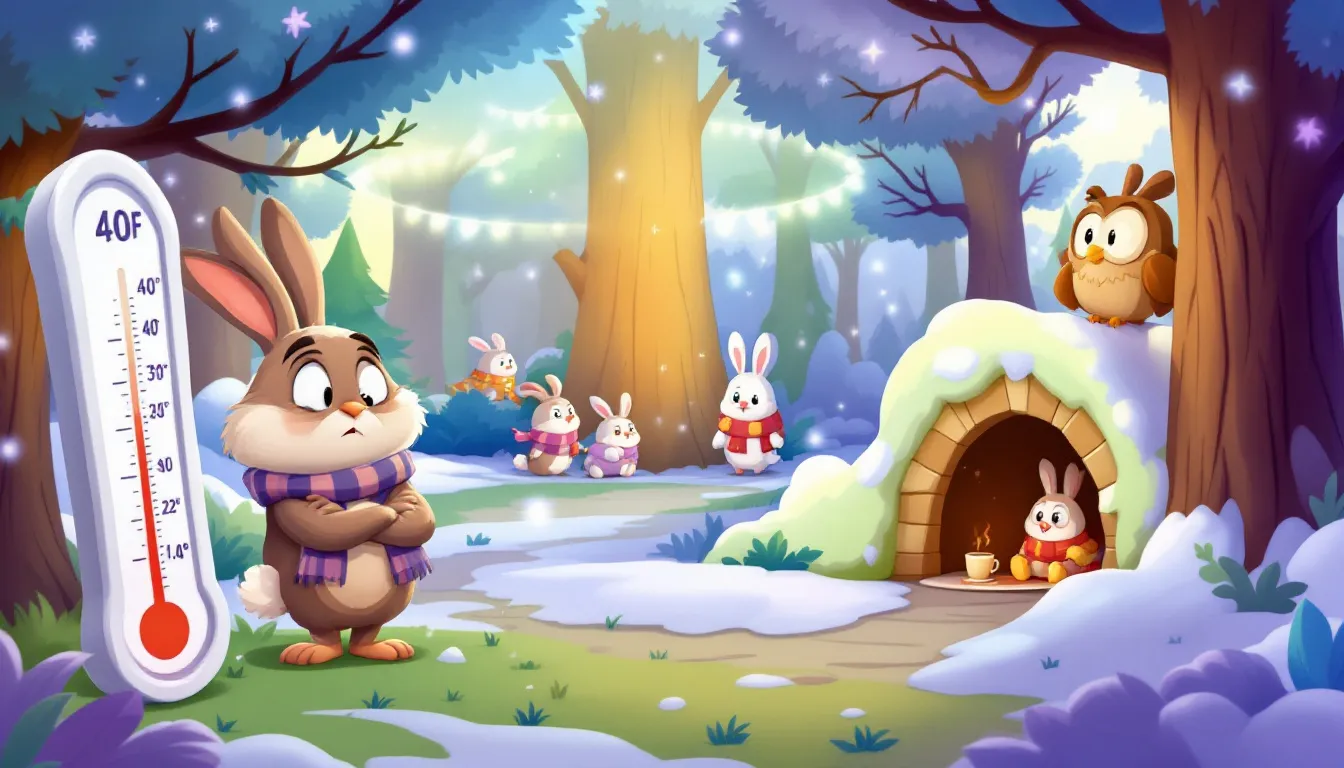
Rabbits are surprisingly resilient when it comes to cold weather. Unlike many other pets, they can handle temperatures that might seem pretty cold to us. Domestic rabbits are generally safe in temperatures above 32°F (0°C), but prolonged exposure below this can be harmful. They have a few tricks up their sleeves to stay warm, such as developing a thicker fur coat in winter, which helps maintain body heat.
However, rabbits are more tolerant of cold than heat. Temperatures over 80°F (27°C) pose a significant risk for heat stress, which can be life-threatening. To cope with the cold, rabbits reduce blood supply to their nose and ears and may shelter in bedding or huddle together. Cold ears are a clear indicator that your rabbit is feeling chilly.
Understanding these adaptations helps us appreciate the measures rabbits take to stay warm. But it’s crucial for us, as pet owner to provide additional support during colder temperatures to ensure their well-being.
Ideal Temperature Range for Rabbits
The ideal temperature range for pet rabbits lies between 60-70°F. This range ensures they remain comfortable without expending too much energy to regulate their body temperature. When temperatures drop below this range, rabbits face a risk of health problems. Monitoring the weather closely and taking steps to keep them warm is important.
If temperatures drop significantly, consider bringing your rabbits indoors or providing additional heating in their hutch. While rabbits can manage temperatures up to 77°F, prolonged exposure to such warmth can also lead to heat-related issues. Striking the right balance is key to maintaining your rabbit’s health and comfort.
Recognizing Signs of Cold Stress in Rabbits
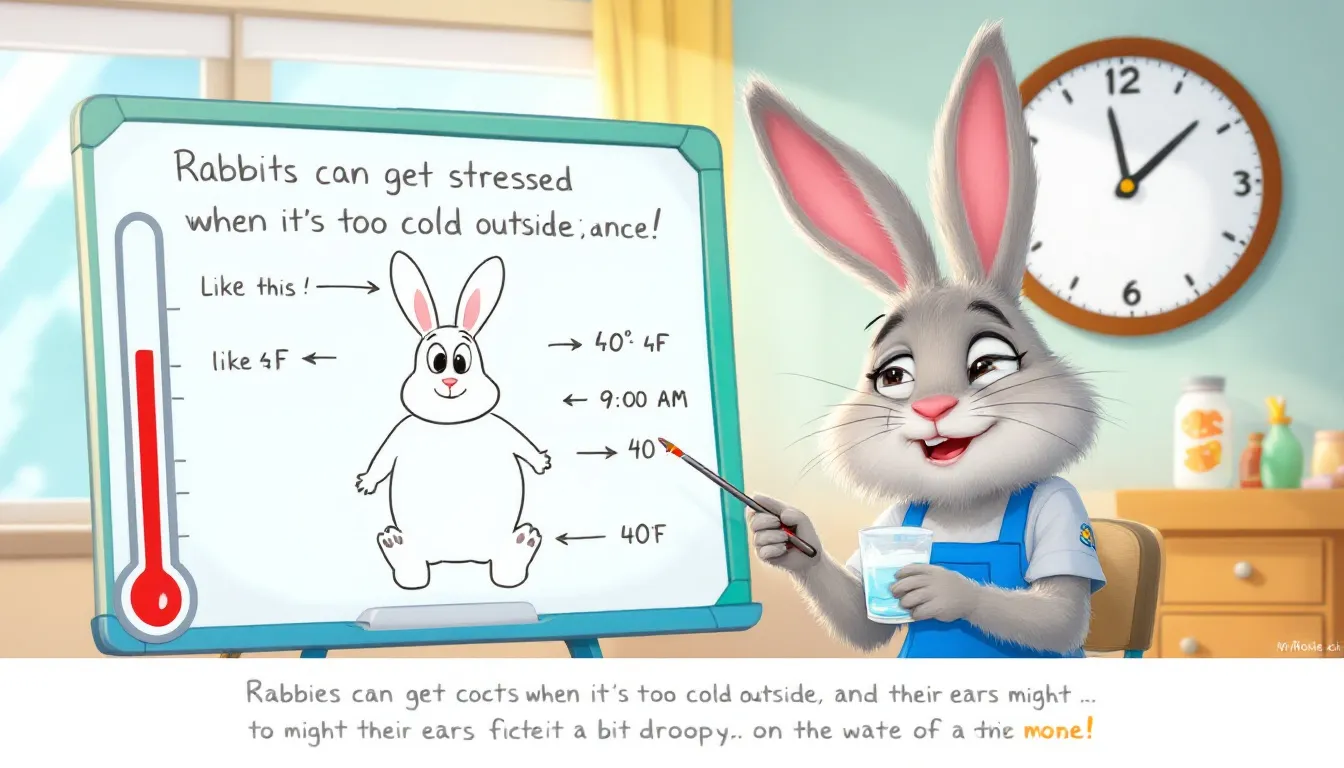
Noticing when your rabbit feels cold is vital for their well-being. Signs of discomfort in cold weather include shivering and excessively fluffing up their fur. These are their natural responses to conserve body heat.
More severe symptoms of cold stress include increased lethargy and reluctance to move from their spot. If you observe these behaviors, act immediately to warm them up. Rabbits suffering from hypothermia may display symptoms like weak pulses, shallow breathing, and may feel cold in their extremities. These signs indicate a serious health issue that requires urgent attention.
Other indicators of cold-weather health issues in rabbits include a pale appearance, shallow breathing, and a weak heartbeat. Regularly checking on your rabbits and being aware of these signs can help prevent severe cold stress and ensure timely intervention, ultimately supporting rabbits’ health.
How to Keep Your Rabbit Warm
Keeping your rabbit warm during winter requires practical steps. First, insulating the rabbit hutch is essential to protect them from cold winter temperatures. Adding layers of extra hay or straw in the sleeping area can significantly help keep rabbits warm during winter. This bedding material helps them retain body heat and stay cozy.
Older rabbits often require more bedding to stay warm during cold weather and may need a gradual adjustment to indoor environments. Ensuring a consistent supply of fresh water bottles is also important, as water can freeze in cold weather. Keeping the environment a bit warmer can also help them adjust.
Using a hot water bottle or heat pads can provide additional warmth, but always ensure they are safely covered to prevent burns. These tips help create a warm and comfortable environment for your rabbits, ensuring they stay healthy and happy throughout winter.
Preparing the Rabbit Hutch for Winter
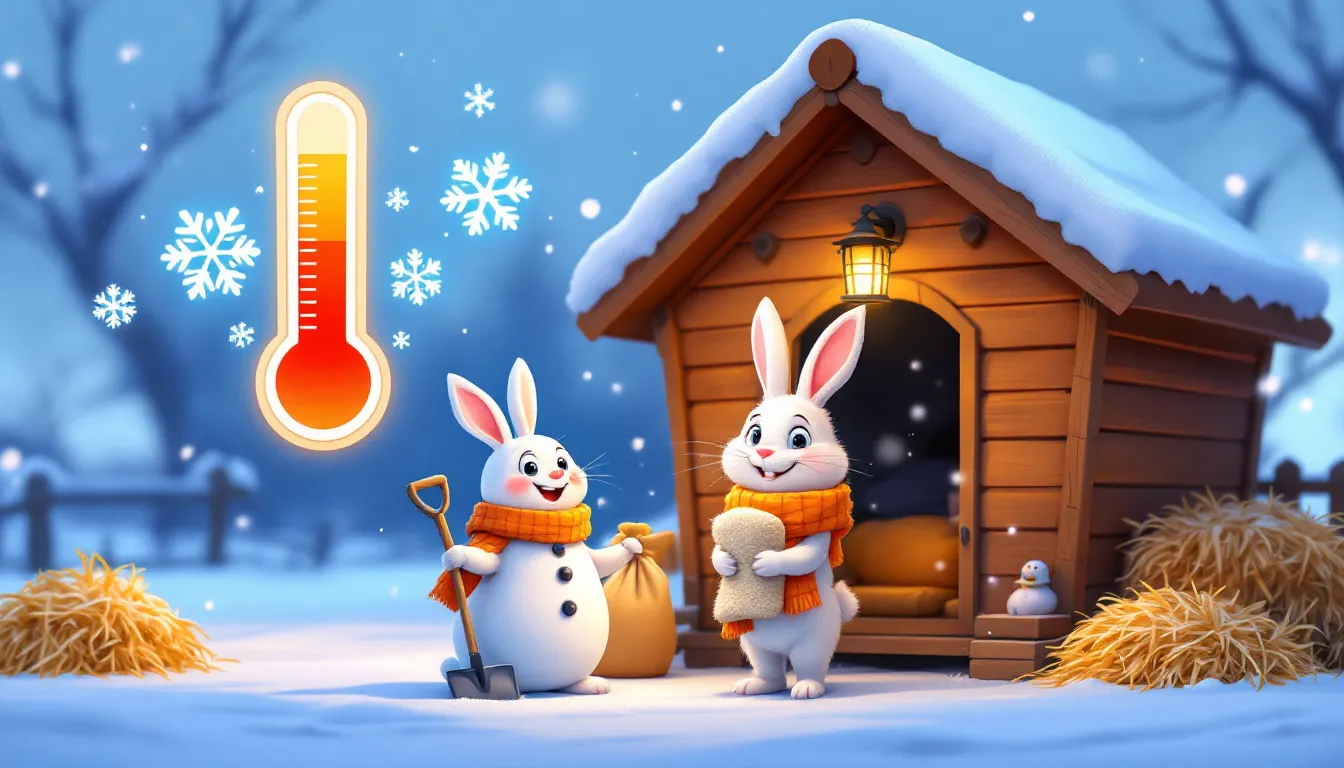
Preparing your rabbit’s hutch for winter safeguards them against harsh weather conditions. Insulated housing or an indoor shelter protects pet rabbits from cold weather. You can use cardboard boxes for walls and layers of newspaper for floors to insulate the hutch. Ensure it is leak and draught-proof for maximum protection.
Covering the rabbit’s hutch with plastic sheeting helps to block wind and snow, creating a more comfortable environment for your rabbits. A rolling drop curtain made of plastic sheeting can be installed at the front of the hutch to provide additional protection from harsh weather.
The recommended temperature range for outdoor rabbits is between 54°F and 70°F. Keeping the hutch within this range ensures your rabbits stay warm and healthy throughout the winter.
Bringing Your Rabbit Indoors
If extreme weather conditions are expected, it might be best to bring your rabbit indoors. Bringing the hutch inside a shed or garage can protect them from freezing winds and snow. To reduce stress, the move indoors should be gradual, starting in a cooler space before transitioning to a heated area.
Maintaining a calm environment during the transition minimizes disruption from sudden temperature changes for your rabbit. Indoor setups should be placed away from drafts and heating vents to ensure a stable temperature in the living area that can tolerate temperatures comfortable for the rabbit.
Unlike wild rabbits, domestic rabbits require controlled environments as a single rabbit bunny indoor rabbit, to stay warm and safe from the cold.
Special Care for Elderly and Sick Rabbits
Elderly and sick rabbits need extra care during the long winter. Rex rabbits and older or disabled elderly rabbits may have more difficulty staying warm. Providing extra bedding and a warm environment is essential.
Hypothermia in rabbits is indicated by the rabbit’s body temperature below 38.5°C. Regularly monitoring their normal rabbit body temperature and seeking veterinary care if needed is important. Keeping these rabbits indoors or in a well-insulated hutch helps them stay comfortable and healthy during the cold months, especially when the temperature drops. A low body temperature can be a sign of hypothermia in these animals.
Wild Rabbits vs. Domestic Rabbits in Winter

Wild rabbits have evolved to survive harsh winters, unlike their domestic counterparts. They rely on ground burrows for shelter, which provide warmth and protection from predators. These burrows are insulated and help maintain a stable temperature even in freezing conditions.
Wild rabbits continuously forage for food throughout winter, eating bark, twigs, and dried grass. They develop a thicker winter coat that helps insulate them against cold temperatures. This natural adaptation is a huge difference between wild and domestic rabbits.
Domestic rabbits, on the other hand, need human assistance to stay warm and healthy. Proper shelter, insulation, and food are critical for their survival during the winter months. Additionally, understanding the differences between male and female rabbits can aid in providing tailored care for your pet.
Common Health Issues in Winter Rabbits
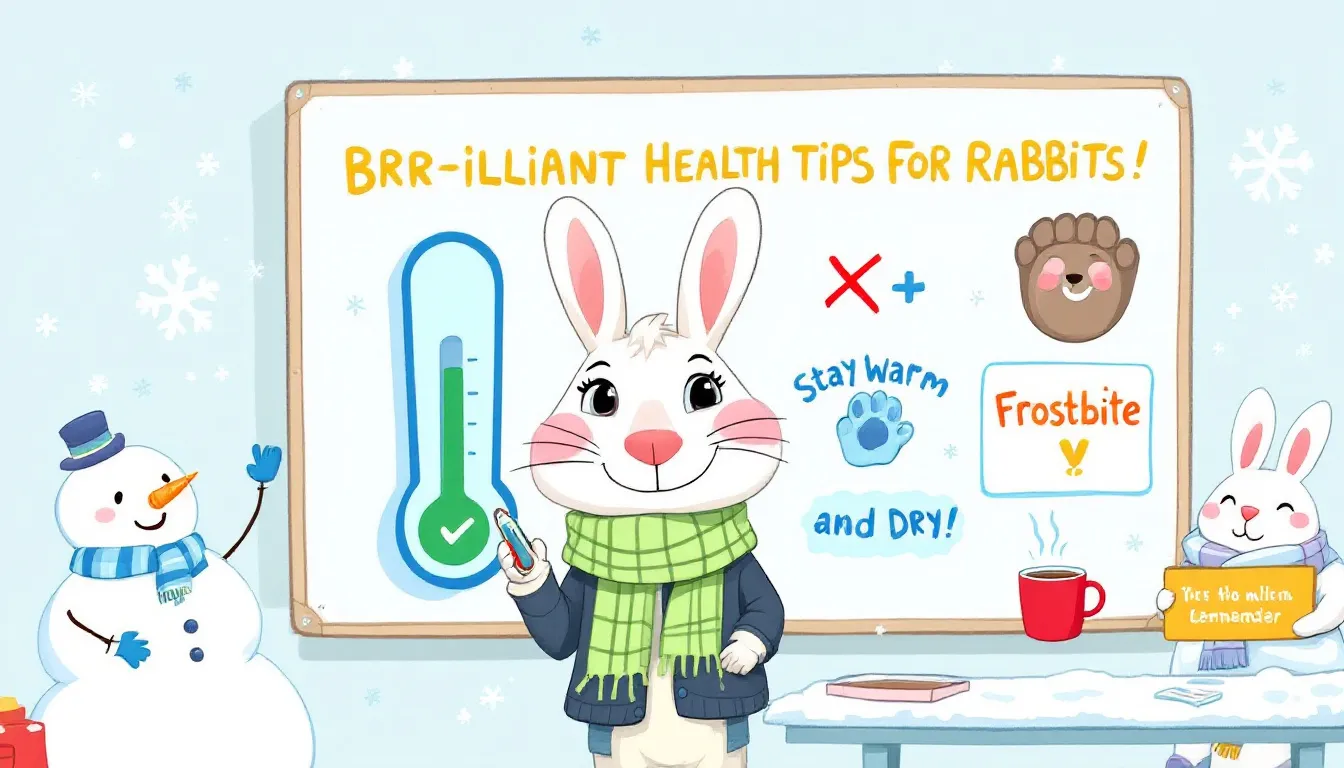
Winter poses several health risks for domestic rabbits. Frostbite is a common issue caused by exposure to freezing temperatures, often affecting the ears and toes. Hypothermia is another serious condition that needs immediate veterinary attention to avoid coma or death.
Signs of cold stress in rabbits include a decrease in appetite and potential dehydration. Regularly checking on your rabbits and being aware of these symptoms can help prevent severe health issues and ensure timely treatment.
Ensuring Proper Nutrition During Winter
Proper nutrition is vital for maintaining your rabbit’s body heat during winter. Outdoor rabbits need extra food to generate body heat and maintain energy levels. They may eat more hay to stay warm and healthy, which means they require more calories.
Fresh vegetables like romaine lettuce and kale are important for their diet and should not be frozen. High-quality rabbit pellets can be given in moderation to complement hay, avoiding excess to prevent obesity. Ensure their food does not freeze, as frozen food should be removed immediately.
Summary
Winter care for rabbits involves understanding their cold tolerance, recognizing signs of cold stress, and taking steps to keep them warm. Preparing their hutch, considering bringing them indoors, and providing proper nutrition are key elements to ensure their well-being.
By following these tips, you can keep your rabbits healthy and happy throughout the winter. Remember, your rabbits rely on you for their care, so take the necessary steps to provide a warm and safe environment for them.
Frequently Asked Questions
How cold is too cold for a pet rabbit?
It’s best to keep your pet rabbit in temperatures above 32°F (0°C), as prolonged cold can be harmful to them. Make sure they have a cozy space to stay warm!
What is the ideal temperature range for pet rabbits?
The ideal temperature range for pet rabbits is between 60-70°F. Keeping them within this range will ensure they stay comfortable and healthy.
How can I tell if my rabbit is too cold?
If your rabbit is shivering, fluffing up its fur, lethargic, or has cold extremities, it’s likely too cold. Keep an eye on these signs to ensure your furry friend stays warm and cozy!
What should I do to keep my rabbit warm in winter?
To keep your rabbit warm in winter, insulate its hutch, add extra bedding, and consider using a hot water bottle or heat pads. Don’t forget to provide fresh water as well!
How do wild rabbits cope with winter compared to domestic rabbits?
Wild rabbits cope with winter by using underground burrows for warmth and foraging for their food, while domestic rabbits rely on humans for shelter, insulation, and nourishment. So, it’s essential to provide your pet rabbit with the right care during those chilly months.

